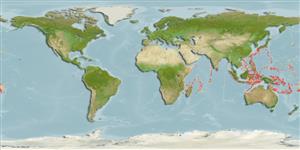Elasmobranquios (tiburones y rayas) (sharks and rays) >
Carcharhiniformes (Ground sharks) >
Pentanchidae (Deepwater catsharks)
Etymology: Apristurus: a-, Latin privative, i.e., without; pristis, from pristes (Gr.), sawyer (but here meaning saw); oura (Gr.), tail, referring to absence of saw-toothed crest of enlarged dermal denticles along upper edge of caudal fin as found in the closely related Pristiurus (=Galeus) (See ETYFish); longicephalus: longus (L.), long; cephalus, from kephale (Gr.), head, about ¼ of total length (See ETYFish).
Environment: milieu / climate zone / depth range / distribution range
Ecología
marino batidemersal; rango de profundidad 680 - 950 m (Ref. 97621). Deep-water; 39°N - 22°S
Indo-West Pacific: Seychelles, Japan, East China Sea, Philippines, and Australia. New specimens were caught off western New Caledonia (Coriolis Bank, Lansdowne Bank, Lord Howe Ridge and Fairway Ridge) and off Mozambique (Ref. 53905).
Length at first maturity / Tamaño / Peso / Age
Maturity: Lm 51.0 range ? - ? cm
Max length : 60.0 cm TL macho / no sexado; (Ref. 559)
Espinas dorsales (total) : 0; Espinas anales: 0. Grey-black, without conspicuous markings (Ref. 244).
Inhabits deep water, probably near the bottom (Ref. 11146). Oviparous (Ref. 50449). First record of a cartilaginous fish manifesting rudimentary hermaphroditism (Ref. 53905). Biology little known (Ref. 6871).
Life cycle and mating behavior
Madurez | Reproducción | Puesta | Huevos | Fecundidad | Larva
Oviparous, paired eggs are laid. Embryos feed solely on yolk (Ref. 50449). First record of a cartilaginous fish manifesting hermaphroditism which is further classified as rudimentary hermaphroditism (Ref. 53905).
Compagno, L.J.V., 1984. FAO Species Catalogue. Vol. 4. Sharks of the world. An annotated and illustrated catalogue of shark species known to date. Part 2 - Carcharhiniformes. FAO Fish. Synop. 125(4/2):251-655. Rome: FAO. (Ref. 244)
IUCN Red List Status (Ref. 130435: Version 2024-2)
Human uses
Pesquerías: escaso valor comercial
Herramientas
Special reports
Download XML
Fuentes de Internet
Estimates based on models
Preferred temperature (Ref.
123201): 5.2 - 7.4, mean 6 °C (based on 99 cells).
Phylogenetic diversity index (Ref.
82804): PD
50 = 0.5000 [Uniqueness, from 0.5 = low to 2.0 = high].
Bayesian length-weight: a=0.00355 (0.00175 - 0.00721), b=3.08 (2.90 - 3.26), in cm total length, based on LWR estimates for this (Sub)family-body shape (Ref.
93245).
Nivel trófico (Ref.
69278): 3.9 ±0.4 se; based on size and trophs of closest relatives
Resiliencia (Ref.
120179): Muy bajo, población duplicada en un tiempo mínimo superior a 14 años (Fec assumed to be <10).
Fishing Vulnerability (Ref.
59153): Moderate vulnerability (44 of 100).
